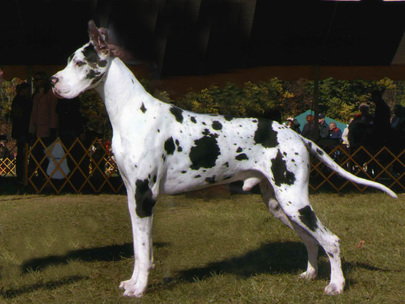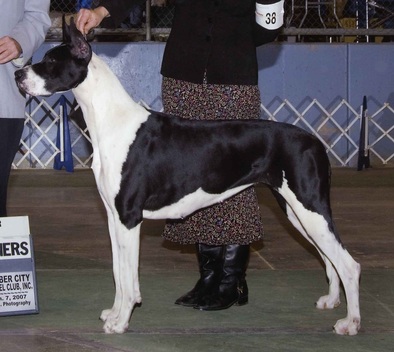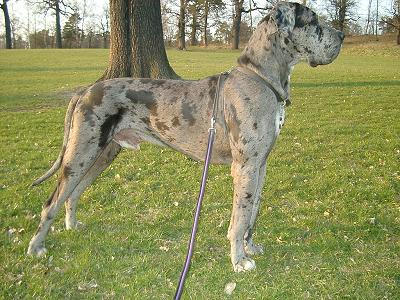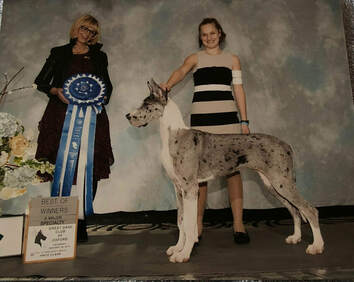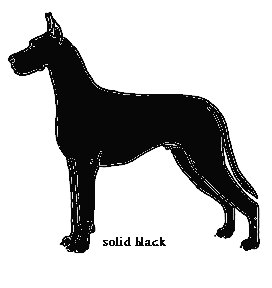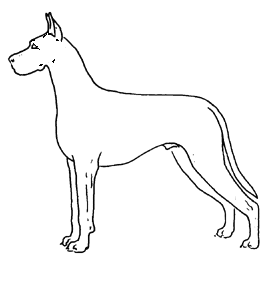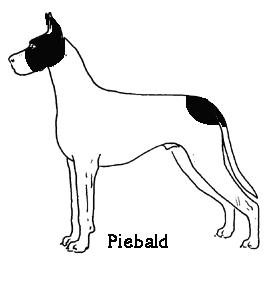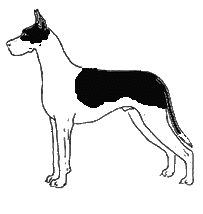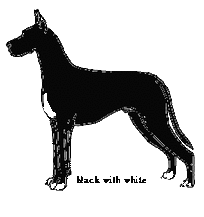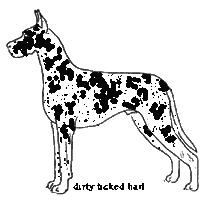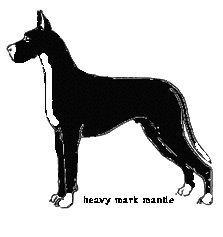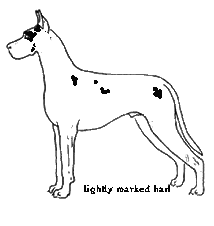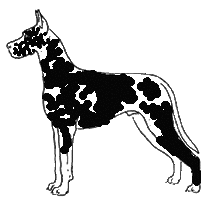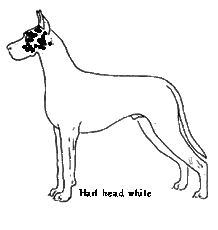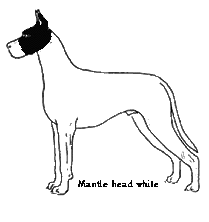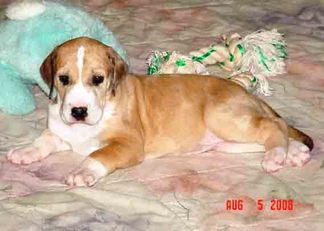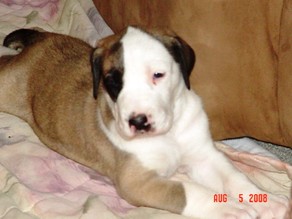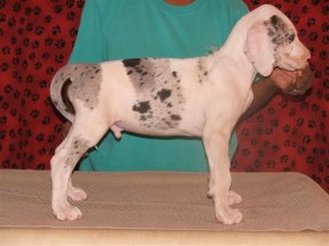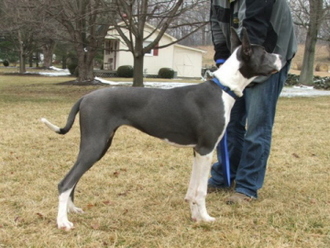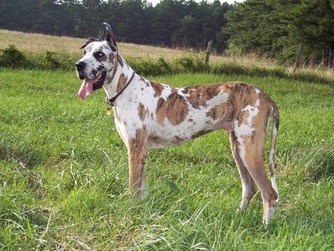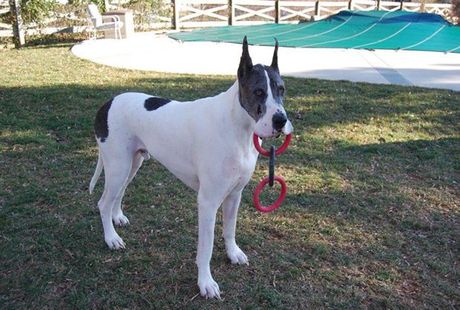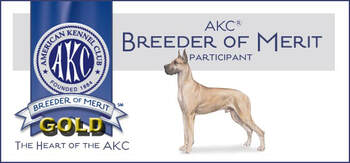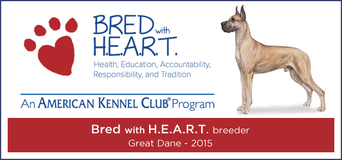The Harlequin breeding
HarlequinHarlequin - Base color shall be pure white with black torn patches irregularly and well distributed over the entire body; a pure white neck is preferred. The black patches should never be large enough to give the appearance of a blanket, nor so small as to give a stippled or dappled effect. Eligible, but less desirable, are a few small gray patches, or a white base with single black hairs showing through, which tend to give a salt and pepper or dirty effect. Any variance in color or markings described above shall be faulted to the extent of the deviation. Any Great Dane which does not fall within the above color classifications must be disqualified.
Standard GDCA. |
MantleMantle - The color shall be black and white with a solid black blanket extending over the body; black skull with white muzzle; white blaze is optional; whole white collar preferred; a white chest; white on part or whole of forelegs and hind legs; white tipped black tail. A small white marking in the black blanket is acceptable, as is a break in the white collar. Standard GDCA
|
Merle |
|
Merle: Color - A pale gray to dark gray merle base color with black torn patches within. Patterns and Markings - May be a Solid Merle (white on chest and toes permissible) or a Merle with a Mantle Pattern ( solid merle blanket extending over the body; merle skull with a white muzzle; white blaze is optional ; whole or partial white neck; a white chest; white on whole or part of the forelegs and hind legs ; white tipped merle tail. A small break in the blanket is acceptable. Black pigment may be seen on the skin in the white areas. Disqualification - Merlequin, a white dog with ONLY patches of merle.
|
Black out of HarlequinThe Harlequin breeding can also produce solid black and variations of that color, black with white. White markings are sometimes found on the chest and toes with out white on the tip of the tail. This dog is an acceptable show color for the black class but would be bred to harl/mantle color.
|
WhiteThe white Dane can be produced from a breeding as well. These dogs are usually absent of color or have very little color on the body. This color is not to be mistaken for and Albino, it is a lack of color that makes it white. White danes can be deaf and blind, this does not mean that every one born will be. The merle gene doubled up creates the white in the coat. Whites can be tested for the merle gene. The test shows one copy or two of the merle gene.
|
Piebald markingThis pattern can come in several colors merle or harl in the same areas as the black is shown in the diagram above. The patches on the dane appear very rounded looking and have smooth edges and very different from the "torn" look of harlequin pattern. Often you will see skin spots on the dog that shows through the white fur that gives the coat a speckled appearance.
|
Deviations to the pattern
The above patterns or color: Left to right: Under marked Mantle, Black with White, Dirty or ticked Harlequin
The above patterns or color left to right: Over marked Mantle (note the white tip on the tail) Lightly marked Harlequin, Heavy marked Harlequin
The above pattern or color left to right: Both are variations of the piebald pattern Harlequin headed white and a Mantle headed white. These can be in black and white or merle and white.
The following colors/patterns are others you may sometimes see in the harl/mantle breeding, these are not RARE or EXOTIC they are in no way any of the above and are often the result of a recessive gene that is being carried or from people cross color breeding.
Fawn merled mantle(L) and the Fawn Mantle (R). These pups are from a recessive fawn gene. The litter mates to these puppies were harls and mantles.
Left is a Merlequin and on the Right is a blue Mantle. The merlequin is a product of a harl/mantle litter and is a color that is often seen in the litter. The blue mantle is a recessive blue gene that has come forward in this litter. There are Blue Harlequins that are shown in other countries.
This is the product of just cross color breeding. He is beautiful but not what we normally see in a litter. This is not rare and is not a new color.
This is an example of a Piebald or as we call them "pied". This is "Moby" is a Pied Merle a boy from my first litter.
Credits: GDCA Standard
Credits: GDCA Standard
Dogs do speak, but only to those who know how to listen. ~ Orhan Pamuk
PROUDLY BRED BY AN AKC GOLD BREEDER OF MERIT AND H.E.A.R.T
(HEALTH, EDUCATION, ACCOUNTABILITY, RESPONSIBILITY & TRADITION)
PROUDLY BRED BY AN AKC GOLD BREEDER OF MERIT AND H.E.A.R.T
(HEALTH, EDUCATION, ACCOUNTABILITY, RESPONSIBILITY & TRADITION)
Created and maintained by Ellenni Danes all rights reserved. All material and pictures with in these pages are
property of Ellenni Danes and may not to be reproduced with out written permission.
Website Designed and maintained by Ellenni Danes
property of Ellenni Danes and may not to be reproduced with out written permission.
Website Designed and maintained by Ellenni Danes
